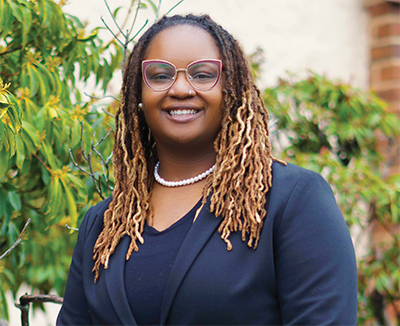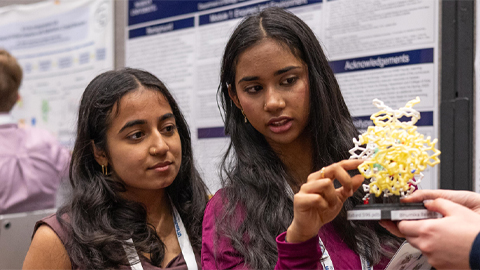Understanding the link between metabolism and aging
 In addition to her research, Melanie McReynolds does motivational speaking, sharing her insight with grad students and undergrads.courtesy of melanie McReynolds
In addition to her research, Melanie McReynolds does motivational speaking, sharing her insight with grad students and undergrads.courtesy of melanie McReynolds
Growing up in rural Mississippi, Melanie McReynolds used to watch St. Jude Children’s Research Hospital infomercials that focused on scientists and their findings; those TV segments sparked her interest in research.
“At a young age, I didn’t realize the in-depth scientific process I was learning, but it was so inspirational to hear and see the scientific story unfold and come to life,” she said.
“And then in college, I was intrigued by the ability to ask and answer questions of the unknown.”
McReynolds followed in her parents’ footsteps and attended Alcorn State University in Mississippi for her undergraduate studies. After her sophomore year, she was one of 10 top Alcorn students selected for a research trip to Bangalore, India.
“This was my first experience with biomedical research,” she said. “It changed my life and promoted my love for science.”
She also participated in the now-defunct Alcorn State/Penn State Bridges to the Doctorate Program, funded by the National Institutes of Health to promote science training for underrepresented minorities. At the program’s end, McReynolds had a bachelor’s degree from Alcorn and a master’s from Penn State, where she did research in Craig Cameron’s lab. The Bridges program triggered her interest in diseases related to metabolism and aging.
Now a Howard Hughes Medical Institute Hanna Gray fellow and postdoctoral research assistant at Princeton University, McReynolds studies diseases of aging in Joshua Rabinowitz’s lab. She focuses on how the molecule nicotinamide adenine dinucleotide, or NAD+, is produced and used. Because NAD+ can carry electrons between chemical reactions, it is involved in myriad processes within cells.
Previous studies have associated a decline in NAD+ with aging and disease, and McReynolds describes the molecule as a “master regulator” of age-dependent pathology. She investigates NAD+ metabolic flux in young and old mice, using isotope labeling, mass spectrometry and quantitative modeling to understand how the rates of production and consumption of the NAD+ chemical backbone vary between these groups.
“These are fundamental questions the field needs answered,” McReynolds said. “Our initial results are exciting and will hopefully be published soon.”
This type of metabolic flux analysis isn’t new to McReynolds. As a graduate student in Wendy Hanna–Rose’s lab at Penn State, she studied NAD+ biosynthesis. She pioneered many mass spectrometric and isotopic labeling techniques to study the physiological roles of NAD+ in the nematode Caenorhabditis elegans.
“I’d never worked with nematodes before, and it was fascinating to integrate genetics, metabolism and biochemistry all together,” she said.
She received numerous awards for her work, including the American Society for Biochemistry and Molecular Biology 2016 Best Poster Award in the category metabolism, disease and drug design. She defended her thesis in 2017 and credits Hanna–Rose with molding her as a scientist and teaching her to think outside the box.
“Melanie approached her research with confidence from the start,” Hanna–Rose said. “She liked to think creatively about how to approach problems, and it was fun to see her mature in this creativity to start focusing it in productive directions.”
Inspired in part by a love of teaching and mentoring, McReynolds decided to stay in academia, leading to her position at Princeton. She also wants to lead by example.
“I want there to be a lot of people of color in tenure positions,” she said. “I want to make sure I can be an example for others, or a representation for others, who also want to pursue academic science.”
McReynolds has struggled with doubt and adversity. During her second year as a graduate student, she took a four-part candidacy exam that included a paper critique, paper presentation, research proposal and chalk talk on the proposal.
“I bombed my chalk talk,” she said. “I was still getting familiar with the research, was still learning how to approach it, and had to repeat the chalk talk.”
McReynolds didn’t let this set her back. She learned NAD+ metabolism and biosynthesis in detail, which was important for her current and future research. When the time came for her second chalk talk, her friends showed up with balloons and cheers to show their support. She passed without issue.
“The experience strengthened my foundation,” she said. “I could look at it as something devastating, but I look at it as something that strengthened me as a researcher and scientist.”
McReynolds also does motivational speaking outside the lab, sharing her insight with graduate students and undergraduates majoring in science, technology, engineering and mathematics at various universities. Her go-to advice is useful for scientists and nonscientists alike:
“Trust the process and trust your science. Stay the course. Trust your ideas and questions, and believe in yourself enough to know you can stand behind what you’re producing.”
These words keep McReynolds motivated. She likes the ever-changing nature of scientific research and that every day brings new tasks and new questions.
“The big question and the big picture of where this research can go, that’s what keeps pushing me,” she said. “Plus, the joy of scientific discovery.”
Rabinowitz sees McReynolds’ positivity in action in his lab. She is a methodical and determined scientist, he said, focused on the greater goal even when challenges arise.
“What truly amazes me is her positive attitude during setbacks. I see that her success on this challenging road reflects a tremendous degree of passion, determination and raw intelligence — plus her fantastic can-do attitude.”
Now in her second year of postdoctoral work, McReynolds will continue to analyze NAD+ flux and how it relates to aging and disease. Her HHMI Hanna Gray fellowship ensures $1.4 million in funding over eight years. She aims someday to run her own lab focused on metabolism-related diseases of aging and hopes her research will influence drug discovery to combat these diseases.
Enjoy reading ASBMB Today?
Become a member to receive the print edition four times a year and the digital edition monthly.
Learn moreGet the latest from ASBMB Today
Enter your email address, and we’ll send you a weekly email with recent articles, interviews and more.
Latest in People
People highlights or most popular articles

ASBMB undergraduate education programs foster tomorrow’s scientific minds
Learn how the society empowers educators and the next generation of scientists through community as well as accreditation and professional development programs that support evidence-based teaching and inclusive pedagogy.

Honors for Gagna and Sundquist
Claude Gagna is being honored for the diagnostic tool he developed that uses AI to streamline diagnostics. Wesley Sundquist is being honored for his role in finding that HIV’s capsid was a target for treatment.

Gaze into the proteomics crystal ball
The 15th International Symposium on Proteomics in the Life Sciences symposium will be held August 17–21 in Cambridge, Massachusetts.

Bassler receives National Medal of Science
She was recognized for her research on the molecular mechanisms bacteria use for intercellular communication.

2025 ASBMB election results
Learn about the new president, secretary, Council members and committee members.

2025 PROLAB awardees announced
Seven early-career scientists receive grants to advance their research by working in North American labs.

